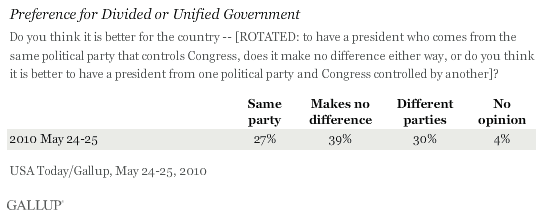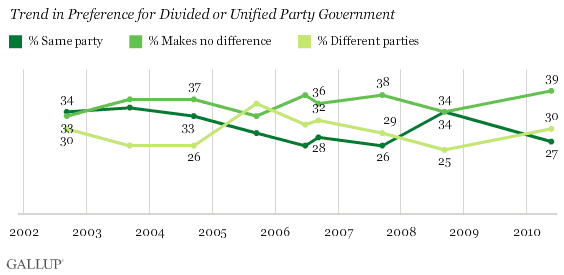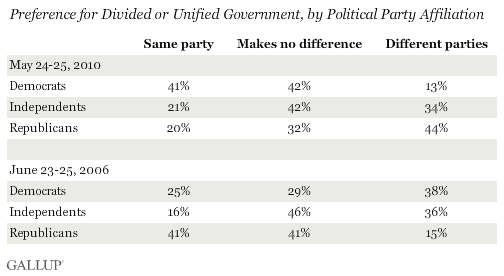PRINCETON, NJ -- A plurality of Americans, 39%, say it makes no difference whether Congress and the presidency are controlled by the same or different parties, while the remainder show nearly equal support for divided (30%) and unified (27%) party government.

The lack of consensus on divided versus unified party government has been the norm in the eight years Gallup has asked this question, with "no difference" usually the plurality response. Americans' relative preferences for divided or one-party government have shifted during this time, reflecting the popularity of the president, and current party control of Congress and the presidency at the time of the survey.

Thus, it appears Americans' attitudes toward divided or one-party government are not fixed but vary to some degree in response to the prevailing political environment.
A look at Americans' preferences by party affiliation makes this clearer. Currently, with a Democratic president and Democratic control of Congress, Americans who identify politically as Democrats show a decided preference for same-party control of the presidency and Congress (41%) over divided control (13%). However, Democrats are about as likely to say it makes no difference as to say it is better to have one-party control.
In contrast, Republicans clearly prefer divided control over unified government, 44% to 20%. And though independents are most likely to say it makes no difference whether the executive and legislative branches are controlled by the same or different parties, more independents prefer divided party control than unified control.
The current preferences by party are essentially the reverse of what was seen in June 2006, when Republicans had control of both houses of Congress and the presidency, and George W. Bush's popularity was sagging.

Bottom Line
Americans have not shown a consistent preference for divided or unified party government in recent years -- typically, the greatest percentage say it makes no difference to the country. This lack of consistency is in part because partisans' preferences appear to be largely contingent on whether divided or unified government would help their party gain the greatest amount of political power they could reasonably expect it to gain in the next election.
Republicans may attempt to promote divided government to encourage votes for Republican candidates in this fall's midterm elections and to serve as a check on President Obama and the Democratically controlled Congress. However, it is not clear from the Gallup data that Americans necessarily view divided government as desirable or unified party control as undesirable.
Survey Methods
Results for this USA Today/Gallup poll are based on telephone interviews conducted May 24-25, 2010, with a random sample of 1,049 adults, aged 18 and older, living in the continental U.S., selected using random-digit-dial sampling.
For results based on the total sample of national adults, one can say with 95% confidence that the maximum margin of sampling error is ±4 percentage points.
Interviews are conducted with respondents on landline telephones (for respondents with a landline telephone) and cellular phones (for respondents who are cell phone only). Each sample includes a minimum quota of 150 cell-phone-only respondents and 850 landline respondents, with additional minimum quotas among landline respondents for gender within region. Landline respondents are chosen at random within each household on the basis of which member had the most recent birthday.
Samples are weighted by gender, age, race, education, region, and phone lines. Demographic weighting targets are based on the March 2009 Current Population Survey figures for the aged 18 and older non-institutionalized population living in continental U.S. telephone households. All reported margins of sampling error include the computed design effects for weighting and sample design.
In addition to sampling error, question wording and practical difficulties in conducting surveys can introduce error or bias into the findings of public opinion polls.
View methodology, full question results, and trend data.
For more details on Gallup's polling methodology, visit www.gallup.com.
